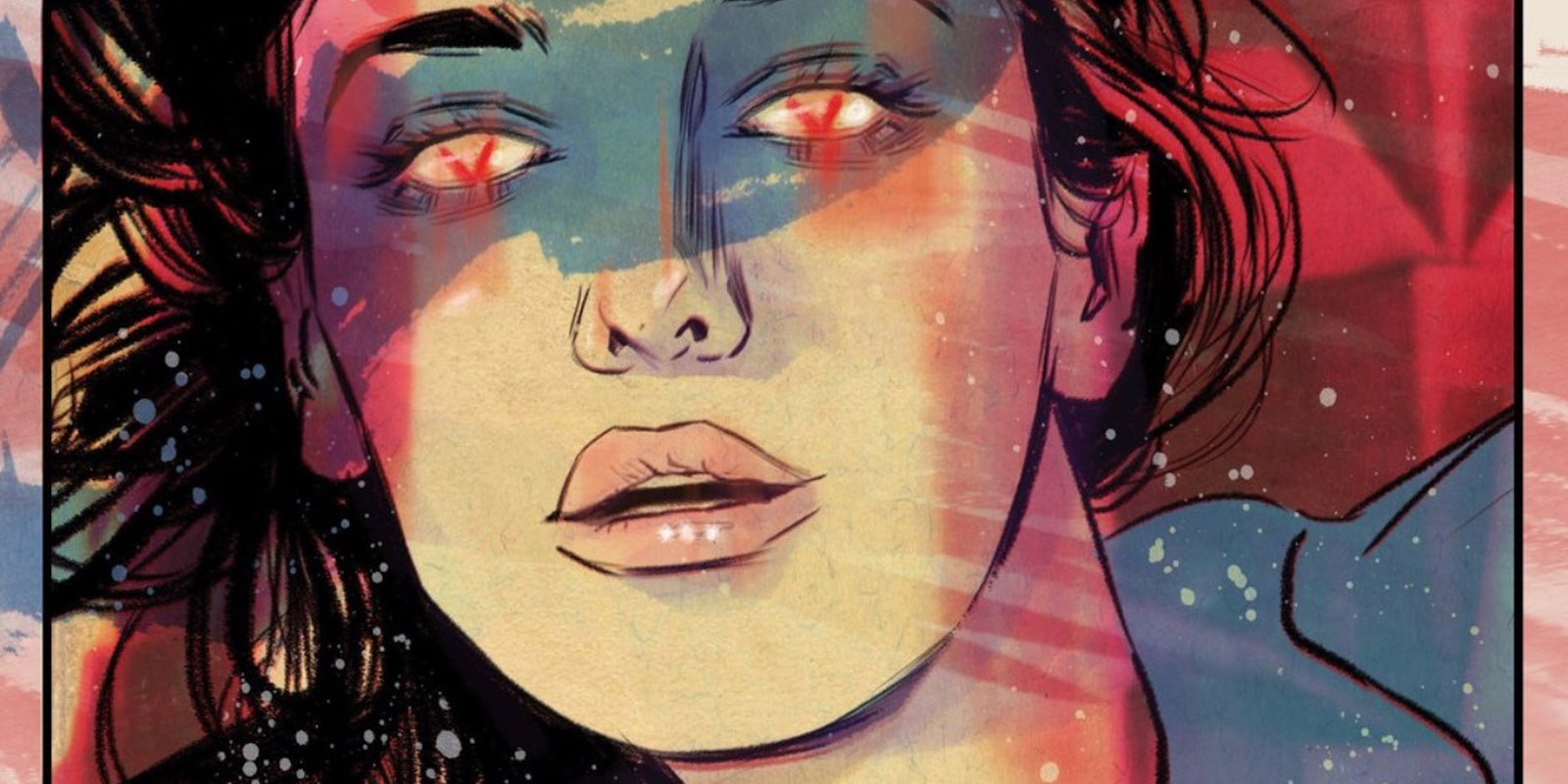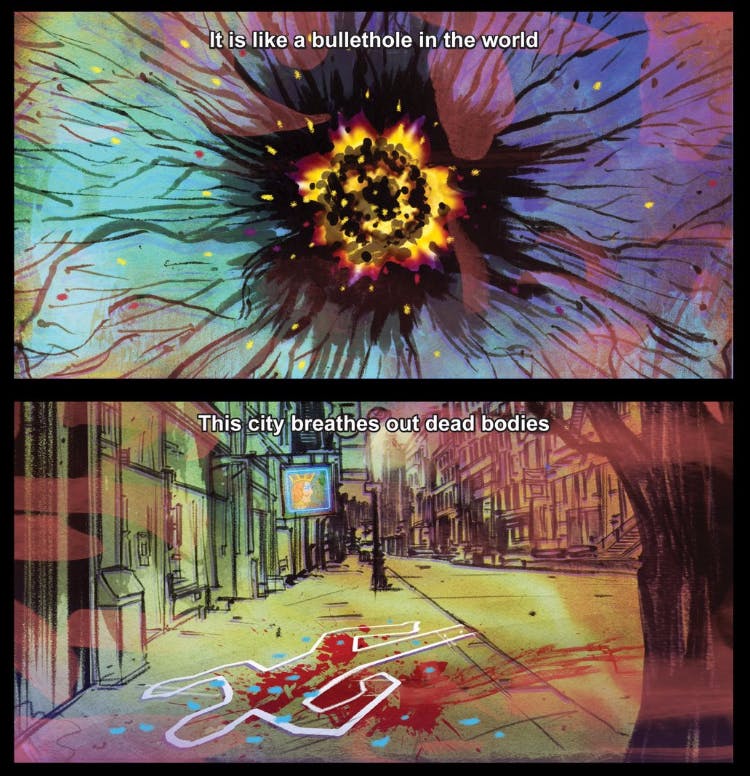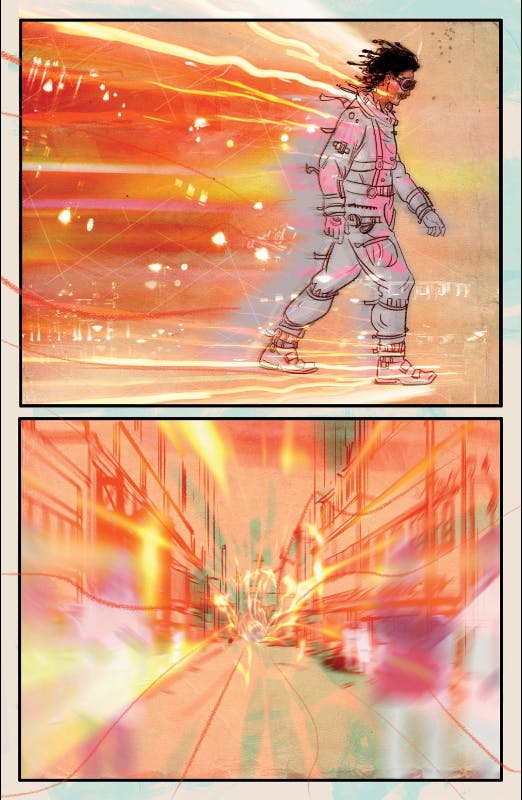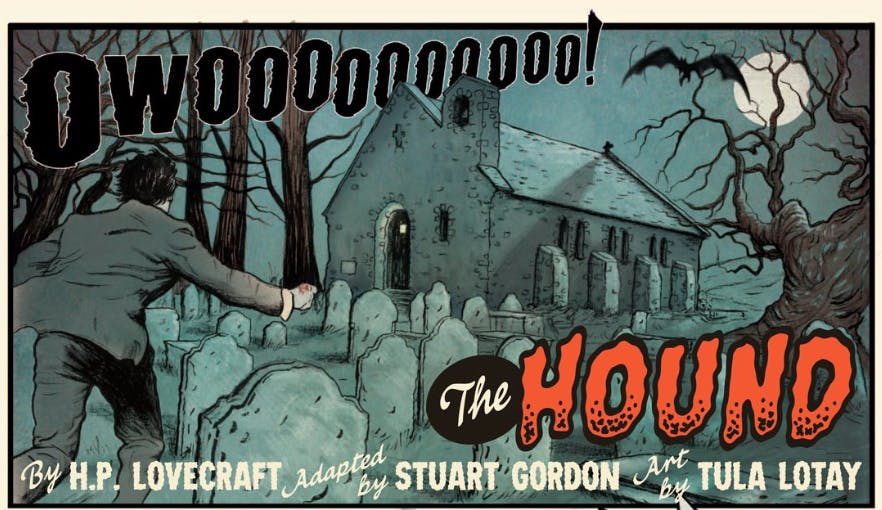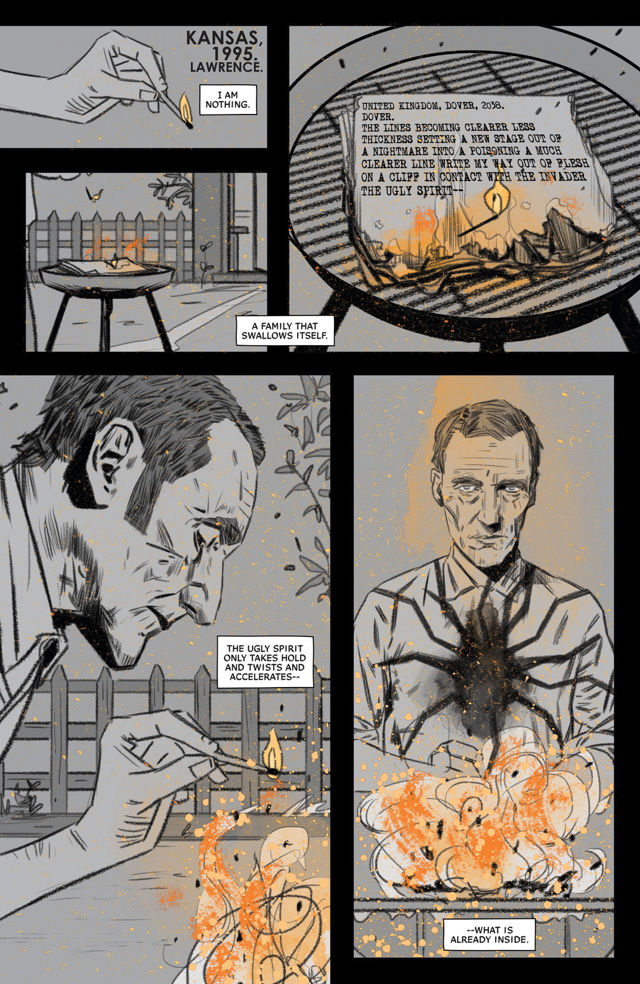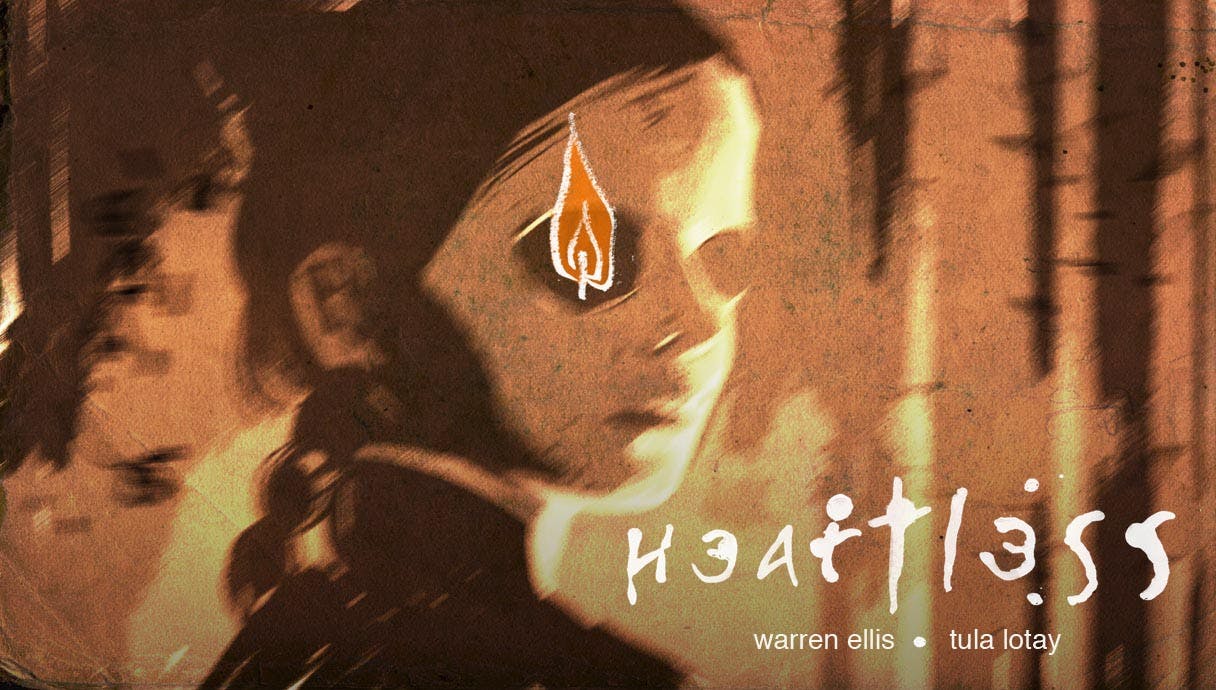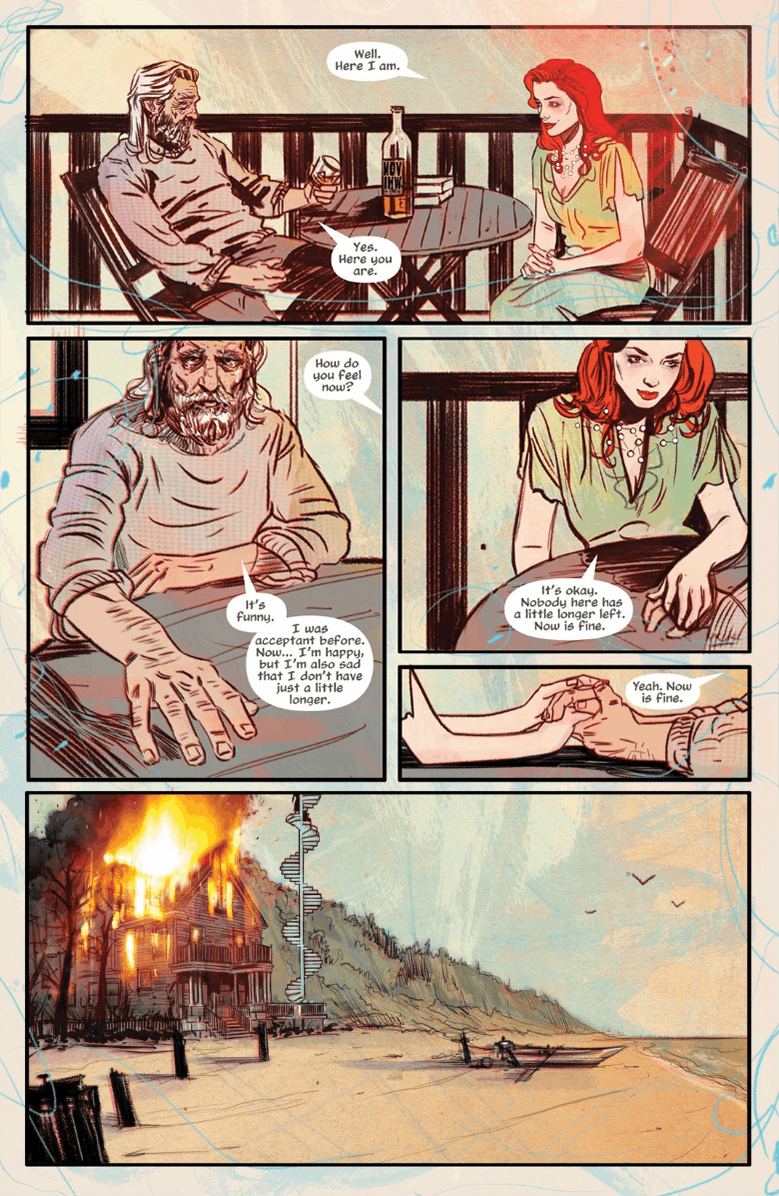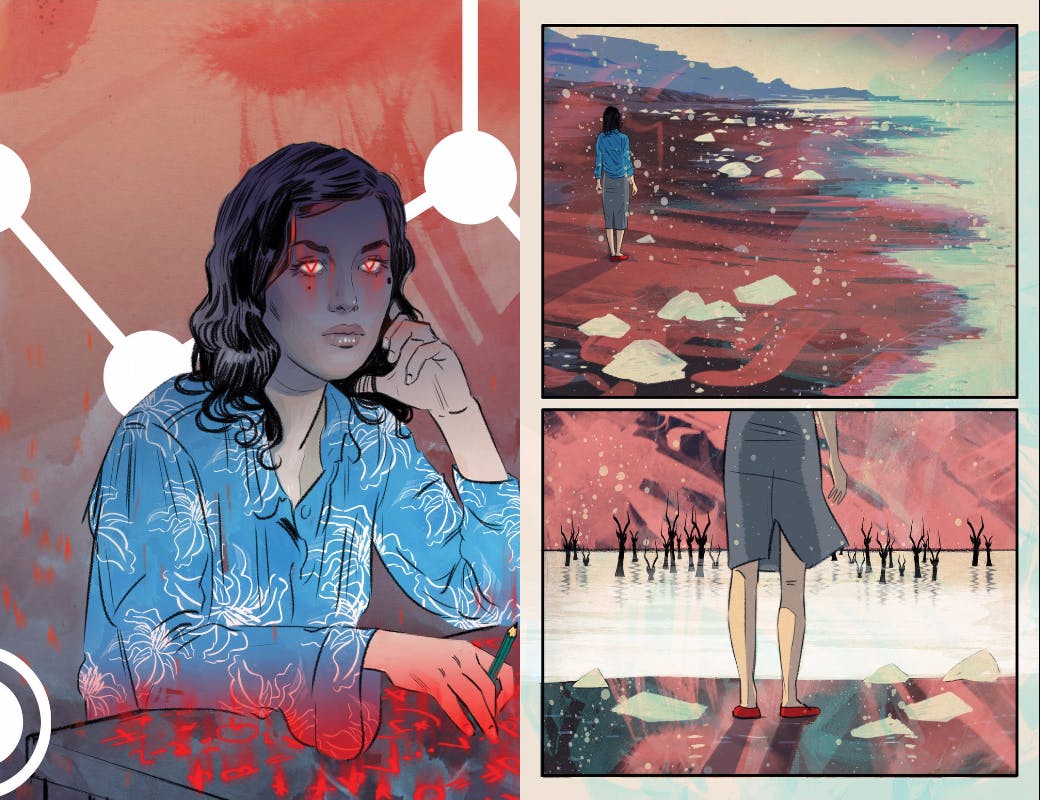Tula Lotay may not have the kind of name recognition enjoyed by her collaborator, legendary writer Warren Ellis.
But that won’t last for long.
Image Comics recently announced their forthcoming comic series Heartless at Image Expo, alongside a huge slate of other creator-owned comics. The series comes on the heels of another Ellis/Lotay collaboration, Supreme: Blue Rose, their eerie mythical take on the classic superhero Supreme. Supreme: Blue Rose turns the focus on his sometime girlfriend Diana Dane, leading her through a mythical journey of self-discovery between time and space.
Although Ellis’ penchant for worldbuilding and deep mythological exploration are on full display in their first collaboration together, the star of Supreme: Blue Rose is Lotay’s artwork—both her expressive lineart and her dazzling use of color to represent emotional moods and landscapes.
Lotay’s art design incorporates color into the storytelling. Throughout the narrative the ink literally flies off the page, imbuing various points of the story with urgency and raw energy.
Before she fully entered the professional side of the comics industry, Lotay was a noted fan. As co-director of Britain’s Thought Bubble comics fest under her real name, Lisa Wood, she spent many years coming into contact with creators and fans of all stripes, including releasing the popular annual Thought Bubble short comics anthology through Image. It was here that fans first saw a glimpse of her remarkable talents as an illustrator, starting with a 2011 adaptation of HP Lovecraft’s “The Hound.”
Eventually, she decided to take the plunge and move into the pro arena, joining a run of Adventures of Superman and a star-studded Dynamite anthology devoted to Red Sonja. But it was with her independent work that she made a name for herself.
Now, Ellis and Lotay are re-uniting for Heartless, described by Image as a “modern folktale about love, revenge, and the deadly grip of the supernatural.”
Here’s the summary:
A female musician returns to northern England, where her family owned a little cottage in the middle of a forest. She wrote her first album there, and she’s “going back to the countryside,” as musicians used to, to write her next one. But the forest doesn’t want her there. She’s returning to face her demons—one in particular—and put herself back together, but the forest remembers what she did, and the devil wants his due.
“I wrote this for Tula,” Ellis said in as press release, “and it’s full of all the stuff we love: the spooky stories, the landscape, the folklore, and the things that haunt us.”
At Comic-Con, we tracked Lotay down and got her to spill her thoughts on collabing with a comics giant, incorporating color into the narrative, the influence of Tarkovsky and David Lynch, and whether Heartless falls into the recent horror resurgence in comics.
If I asked Warren Ellis what it’s like to work with you, what do you think he’d say?
Oh, I don’t know, that’s really clever! [laughs] I like to think I make it easy for him. I mean, I try to. You don’t want to work with anyone that’s hard work. He just does his own thing, and he’ll send me the script, I’ll read through it, and I’m usually blown away by it, because Warren’s writing is absolutely incredible. But what I love is that he gives me the freedom to change things. If I am going to change anything drastically I will check with him first, but usually I just stick to what he has as well and just put my artistic flourish on it.
I would like to think that he thinks it’s an easy thing to do. Because we get on so well, I think when you get on so well with someone and you have very similar interests, you know you’re going to be thinking along the same lines anyway—you don’t have to battle with anyone. That’s a really difficult way to work. Warren and I never have that, ever—we pretty much seem to think down the same route all the time. We both want to take it in a similar direction, so that seems to work really well.
How did you meet?
I can’t remember how I met Warren, actually, but I’ve known him for quite a few years. I think it might have been in a bar, seedy as that sounds. [laughs] I think it might have been at a convention, and we ended up talking in a bar. But I’d emailed him a few times previous, because I wanted him to come to my convention in the U.K., ThoughtBubble. So I think we ended up chatting from there. It was actually Eric Stevenson from Image that saw my work, and he knew that Warren was about to submit a story, and he needed an artist. And Eric said, look, can you collaborate with Lisa? And Warren was like, OK, well, I’ll chat to her.
This was maybe a creator-owned project around the time we were talking about, but then Warren submitted a script for [Supreme: Blue Rose], and I kind of asked him to show it to me, and he said, you won’t like that, it’s a superhero comic, and I was like, well, show it to me, and let me decide, and he showed it to me, and I was just blown away. It was just absolutely incredible. And I think he’d sent the first two issues at that point, and then obviously when I came on board he tailored it a lot more to me and where we wanted to go, and [took] it in a different direction. So, yeah, from that point on, we just enjoyed working together so much. It’s just a pleasure to work with him. I could work with Warren forever.
Did you finish Supreme: Blue Rose and think, we need to work together again right now?
No, it was actually San Diego last year that we met again, and we met in L.A., and we were having drinks in a whisky bar. We were talking about movies and stuff, and we ended up talking about the Russian director Tarkovsky, and how much we love his work.
He’s my favorite.
Yeah, he’s amazing.
I can see that, too, in your aesthetic.
Yeah, yeah? Well, Heartless is going to be a lot like that, because we’re both super into his work. And then we kind of said, ‘Let’s do another project, let’s do a creator-owned work, yeah, let’s do it.’ And Warren went away to think about it, and said, yeah, I really do want to go down this Tarkovsky road. Let’s make it really dark. We’ll make it poetic, and about folklore as well, and I was just like, Warren, you’re saying every single thing that I want to hear, I want to do it, this is going to be amazing.
I was thinking about how when you work for Image you do your own coloring. Is it just independent comics that are giving people the opportunity to be their own colorists?
I don’t think it’s just independent, but I think it’s mainly that because you don’t have the conflict of monthly deadlines. So comics, because they’ve traditionally been monthly periodicals, you’ve always needed a collaborative team, so you always have the pencilist, colorist, letterer. When you’re doing a creator-owned, if it’s a limited run or if it’s in arts, it allows you the freedom to start a lot earlier, to do everything that you want to do. There are artists who are very used to the penciller or inker’s stuff, and a lot of people do that and it really works for them because it means they can get it out every month.
But, when you’re doing your own thing, if you want to color it, it’s a great way to be able to do that. And you see that with people like Neal Stephenson, all the digital comics, because they’re allowed to control the time they put in it, or like, to do all of it. That kind of artistic freedom you have when you do every single thing from beginning to end is incredibly liberating. It’s a lovely thing to do. …
But I think really from my point of view, because I’ve just done pencil, ink, and color, I tend to do some inkwork and then do color over the top and then work into the ink a little bit more. I think I’m at my best when I’m able to do the full process.
And you really integrate color into the story. In Supreme: Blue Rose you can obviously see you’re using color to differentiate between different temporal landscapes. You built the color into the aesthetic of the story.
Yeah. I did. I mean, when you’re doing everything from beginning to end, and you’re working with a script and you’re very clear on the story and the idea of it, you can make those kinds of decisions, and those kinds of decisions can be very important to the storytelling process. Like on Supreme, with all the scratches and marks, I wanted that to bring about a sense of Diana’s mental state. When she’s feeling unsure about things or she doesn’t know what direction to go in or when things are very confused. The reader is kind of distracted, and that distraction is part of how she’s feeling, so they remind the reader hopefully that things aren’t quite right in her head at this point. And then at later points maybe she’s feeling a little bit calmer about things.
I felt like when I was reading Supreme: Blue Rose that there was a Japanese aesthetic there.
Oh, really!
With the scenes of the birds flying, and so forth, it looked almost like a Japanese wood print.
I look at those a lot and nobody’s noticed that before, but I am incredibly inspired by that kind of aesthetic. I think in some way that must filter through. When you look at those Japanese woodcuts, I remember a few years ago I went to an exhibition in London of the guy, [Seiichi] Hiroshima. He’s just incredible. I’m so inspired, especially by the age of the Japanese paper, and it’s gone all yellowy and you have these incredibly delicate lines because of the brushes they use. I’m really inspired by all of that.
What can you tell us that we don’t know about Heartless and the way that the two of you have integrated artwork and story?
It’s hard to comment on it too much because I don’t want to give too much away, but it’s going to be very much based on atmosphere, and it’s going to be dark and spooky. I really—it’s very important to us that people feel very invested in some of the characters. As always, I like to think that the characterization in my work kind of comes through, or at least I try for that to come through. That’s the most important thing for me. So the facial expressions, like in Supreme: Blue Rose with Diana, when she’s feeling upset or scared, that’s kind of key for me in the story.
Because it’s about a lone female protagonist, she’s experiencing a lot of emotions while she goes to her family’s retreat in the forest. She knows it’s a very dangerous place to be, she’s been there before and she grew up there, but she knows she has to go back there to find herself, to take her career in the next direction, because she feels that things are quite stale. She’s already written her first album and she’s venturing back there for the second. So she’ll be alone a lot of the time, but there are characters who pop up throughout it, in the forest especially, that come up and go. Like the girl whose glittering skullless face is on the main poster. Some of them are quite disturbing characters, and what comes back in the end is… I don’t want to give too much away, it’s quite disturbing!
It seems like there’s been a lot of talk about resurgence of horror lately, and I know that’s bled into comics. Were you guys thinking about that trend or did the story unfold on its own?
I mean, absolutely, I’m aware of the industry, even though I haven’t had as much time lately to read comics recently as when I wasn’t drawing, because I’m so busy. But it absolutely came about on its own. It’s not following any kind of horror momentum that’s going on at the moment. From my personal point of view, I’ve always been a horror fan, I grew up watching horror films, it’s my favorite genre. I loved the work of Lucio Fulci, Dario Argento, the Giallo films. I’m a huge fan of all that stuff—any kind of horror. My favorite films are The Thing, Company of Wolves.
I love Company of Wolves.
It’s so good.
It’s so good!
All my favorite films are horror. The Innocents and The Haunting are two of my favorites. [But] even though horror’s my favorite stuff, we didn’t go into the story wanting it to be a horror story, and I actually don’t think it’s a horror story. I’m incredibly inspired by David Lynch. I love his work. David Lynch, I think, has created some of the most terrifying moments in cinema history, but he’s never made an outright horror film. His films contain everything, they’re genre-defying. I kind of want that to be what Heartless is about? It may be very spooky, it may be very dark, but it’s not an outright horror. It’s a story about myth and folklore, with very, very dark moments, but there’s drama in there, and mystery, too. I think it includes all of those aspects, but really above anything else, I think it’s gonna be quite unsettling.
Screengrab via Image Comics
